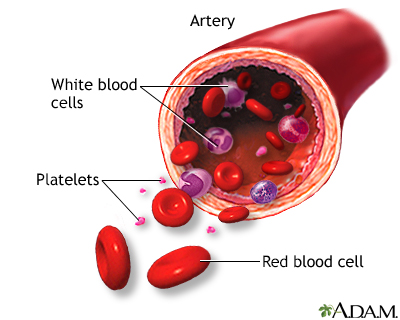WBC count
Leukocyte count; White blood cell count; White blood cell differential; WBC differential; Infection - WBC count; Cancer - WBC count
A WBC count is a blood test to measure the number of white blood cells (WBCs) in the blood. It is a part of a complete blood count (CBC).
WBCs are also called leukocytes. They help fight infections. There are five major types of white blood cells:
- Basophils
- Eosinophils
- Lymphocytes (T cells, B cells, and Natural Killer cells)
- Monocytes
- Neutrophils
Images


Presentation

I Would Like to Learn About:
How the Test is Performed
A blood sample is needed.
How to Prepare for the Test
Most of the time, you do not need to take special steps before this test. Tell your health care provider the medicines you are taking, including the ones without a prescription. Some drugs may change the test results.
How the Test will Feel
When the needle is inserted to draw blood, some people feel moderate pain. Others feel only a prick or stinging. Afterward, there may be some throbbing or slight bruising. This soon goes away.
Why the Test is Performed
You will have this test to find out how many WBCs you have. Your provider may order this test to help diagnose conditions such as:
- An infection
- Allergic reaction
- Inflammation
- Blood cancer such as leukemia or lymphoma
Normal Results
The normal number of WBCs in the blood is 4,500 to 11,000 WBCs per microliter (4.5 to 11.0 × 109/L).
Normal value ranges may vary slightly among different labs. Some labs use different measurements or may test different specimens. Talk to your provider about your test results.
What Abnormal Results Mean
LOW WBC COUNT
A low number of WBCs is called leukopenia. A count less than 4,500 cells per microliter (4.5 × 109/L) is below normal.
Neutrophils are one type of WBC. They are important for fighting infections.
A lower than normal WBC count may be due to:
- Bone marrow deficiency or failure (for example, due to infection, tumor, or abnormal scarring)
- Cancer treating drugs, or other medicines (see list below)
- Certain autoimmune disorders such as lupus (SLE)
- Disease of the liver or spleen
- Radiation treatment for cancer
- Certain viral illnesses, such as mononucleosis (mono)
- Cancers that damage the bone marrow
- Very severe bacterial infections
- Severe emotional or physical stress (such as from an injury or surgery)
- An ethnic/genetic trait (not uncommon in African Americans)
HIGH WBC COUNT
A higher than normal WBC count is called leukocytosis. It may be due to:
- Certain drugs or medicines (see list below)
- Cigarette smoking
- After spleen removal surgery
- Infections, most often those caused by bacteria
- Inflammatory disease (such as rheumatoid arthritis or allergy)
- Leukemia or Hodgkin disease
- Tissue damage (for example, burns)
- Pregnancy
There may also be less common reasons for abnormal WBC counts.
Drugs that may lower your WBC count include:
- Antibiotics
- Anticonvulsants
- Antithyroid drugs
- Arsenicals
- Captopril
- Chemotherapy drugs
- Chlorpromazine
- Clozapine
- Diuretics (water pills)
- Histamine-2 blockers
- Sulfonamides
- Quinidine
- Terbinafine
- Ticlopidine
Drugs that may increase WBC counts include:
- Beta adrenergic agonists (for example, albuterol)
- Corticosteroids
- Epinephrine
- Granulocyte colony stimulating factor
- Heparin
- Lithium
Risks
There is little risk involved with having your blood taken. Veins and arteries vary in size from one person to another, and from one side of the body to the other. Obtaining a blood sample from some people may be more difficult than from others.
Other risks associated with having blood drawn are slight, but may include:
- Excessive bleeding
- Fainting or feeling lightheaded
- Multiple punctures to locate veins
- Hematoma (blood accumulating under the skin)
- Infection (a slight risk any time the skin is broken)
Related Information
CBC blood testBlood differential test
Systemic lupus erythematosus
Rheumatoid arthritis
Allergies
References
Marcogliese AN, Hensch L. Resources for the hematologist: interpretive comments and selected reference values for neonatal, pediatric, and adult populations. In: Hoffman R, Benz EJ, Silberstein LE, et al, eds. Hematology: Basic Principles and Practice. 8th ed. Philadelphia, PA: Elsevier; 2023:chap 159.
Vajpayee N, Graham SS, Bem S. Basic examination of blood and bone marrow. In: McPherson RA, Pincus MR, eds. Henry's Clinical Diagnosis and Management by Laboratory Methods. 24th ed. Philadelphia, PA: Elsevier; 2022:chap 31.
BACK TO TOPReview Date: 2/2/2023
Reviewed By: Mark Levin, MD, Hematologist and Oncologist, Monsey, NY. Review provided by VeriMed Healthcare Network. Also reviewed by David C. Dugdale, MD, Medical Director, Brenda Conaway, Editorial Director, and the A.D.A.M. Editorial team.

Health Content Provider
06/01/2025
|
A.D.A.M., Inc. is accredited by URAC, for Health Content Provider (www.urac.org). URAC's accreditation program is an independent audit to verify that A.D.A.M. follows rigorous standards of quality and accountability. A.D.A.M. is among the first to achieve this important distinction for online health information and services. Learn more about A.D.A.M.'s editorial policy, editorial process and privacy policy. A.D.A.M. is also a founding member of Hi-Ethics. This site complied with the HONcode standard for trustworthy health information from 1995 to 2022, after which HON (Health On the Net, a not-for-profit organization that promoted transparent and reliable health information online) was discontinued. |
The information provided herein should not be used during any medical emergency or for the diagnosis or treatment of any medical condition. A licensed medical professional should be consulted for diagnosis and treatment of any and all medical conditions. Links to other sites are provided for information only -- they do not constitute endorsements of those other sites. © 1997- 2025 A.D.A.M., a business unit of Ebix, Inc. Any duplication or distribution of the information contained herein is strictly prohibited.
